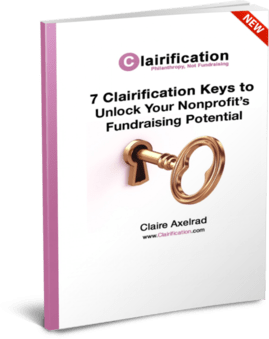
Sustain the positive energy of love and connection
Are you throwing your former board members out like yesterday’s trash?
This may not be your intention, but you’re kind of guilty of this if you don’t continue to (1) let them know how special they are, and (2) build personal relationships with them. After all, one of the foundations of Penelope Burk’s groundbreaking work in Donor-Centered Fundraising is the finding donors want one thing first and foremost: “Show me that you know me.”
Are You Showing Former Board you Know, Love and Feel Specially Connected to Them?
CONSIDER THIS:
- As board members, they got used to being treated as “insiders.”
- Now that they’ve stepped off the board, you’re treating them as if they mean less to you.
Every single communication with a former board member should let them know you know who they are.
If you treat them like they’re toast, don’t be surprised when they start sending you little bread crumbs instead of the whole slice – or loaf – they once sent. People want to be appreciated. It’s just human nature. And facilitating philanthropy (the word literally means “love of humankind”) is a very human endeavor.
Don’t stop loving your former board members.
Stop blaming them for stopping to love you. Blaming is a cop out. Instead, look in the mirror and see what part you may be playing in their changed behavior.
SPECIAL TIP: You can apply much of the suggestions in this article to former staff as well. I often marvel at the hands-off way I’m treated by some of the places where I once worked, sometimes for many years. Places where I donated too, because I believed in the mission. Now I’m just a “prospect” or “lapsed donor” to them, and the communications I receive come across a bit infantalizing. After all, I know this stuff. I wrote a lot of this stuff! It just feels like they’re telling me “since you don’t work here any more, you mean nothing to us.”
Why Former Board Merit Their Own Engagement Strategy
Former board should be one of your top segments for cultivation!
IN A NUTSHELL:
- They have a deep understanding of your vision, mission and values.
- For years, they made your nonprofit one of their top philanthropies.
- They have numerous connections with your cause, including relationships with staff, each other, and even beneficiaries.
- At one point you were part of their identity and family.
- You likely have a special place in their heart.
- They may even have included you in their estate planning!
Don’t stop making beautiful music together! Continue to treat them personally, unless they specifically ask you to stop. Don’t simply relegate them to your impersonal e-news mailings or mass annual appeals. Treat them like major donors and develop a love and loyalty strategy that invites them to stay engaged with you, albeit in a new way.
8 Strategies to Build a Former Board Member Love and Loyalty Strategy
1. Create an ad hoc “Champions” Group
This can be comprised of former board and others (consider former staff too) who care deeply about your organization and still want to serve as ambassadors, advocates and even askers. Develop a job description that makes their role and responsibilities clear.
Assign the job of engaging with them to someone on staff.
Nothing will happen unless you make someone accountable for this strategy (and, yes, it can be you; just let your boss or board know this is now a priority). Doing something as simple as convening your Champions twice a year (even virtually) to offer advice and feedback can go a long way towards keeping them connected. Asking them to convene socially is good too, but most people feel better if they feel useful. So give them a job!
2. Invite them to Tour
This can be done on site or virtually. It’s an opportunity to keep up-to-date, meet new staff, and hear new stories of impact.
It makes former board members feel good to know they laid the groundwork for all the wonderful outcomes that continue.
3. Offer Town Hall Updates
These can be folded into updates you already offer to special segments of your donor base (e.g., major donors; monthly donors; active volunteers) and are a way to show former board they’re still important to you. Once a quarter is a good frequency.
Make sure you include a shout-out to former board and staff so they feel an intergral part of your ongoing story.
4. Invite them to Join a Committee
I’m a firm believer in inviting non-board members to join committees. When you do this with major donors and active volunteers it serves as an onboarding ramp to board service. When you do it with former board and staff, it assures you never lose their support.
Ask a current board member to extend the invitation so former board still feel connected, and wanted by, their peers.
5. Invite them to Join an Ad Hoc Group
In the lifetime of your nonprofit, there are many opportunities to form ad hoc advisory bodies. It may be when you’re considering a merger… beginning a strategic planning process… considering a capital or endowment campaign… entering into a rebranding initiative… and so forth. Why not invite former board, who know a lot about you, to join?
Staff can extend this invitation, noting what they know about the former board member’s areas of expertise and giving them a significant new purpose.
6. Invite them to an Annual Board Appreciation Party
When folks have been treated as members of your family, it can feel bad to be suddenly cast aside. Show them you’ll never do this by routinely including them in at least one purely social celebration.
If you don’t have the bandwidth to do a special party, consider inviting them to one board meeting annually where you add on a special board appreciation component (e.g., a reception beforehand or an ice cream social afterwards).
7. Ask Personally for an Annual Gift
You used to ask them personally, right? This probably worked pretty well. If all of a sudden you start sending only a letter (and heaven forbid it doesn’t even include a personal note from the E.D. or board president), what are they going to think about how you feel about them? Your not treating them special will likely lead to a not-so-special gift.
Think carefully about the best person to make the ask; have them do so face-to-face (virtual is swell), or at least on the phone.
8. Ask for Continued Fundraising Help
Especially if they were helpful with this while on the board, see if they’re willing to continue.
There are many fundraising-adjacent roles in addition to “asker,” including “ambassador” and “advocate.”
Maybe they won’t want to ask, but perhaps they’ll be willing to serve as ambassador at a community event. Or maybe they’d be flattered to be asked to accompany you or another board member to play the role of advocate. Giving testimonial is one of the most powerful things anyone can do, and it’s not a heavy lift. It will make them feel connected, appreciated and useful.
Renew Your Purpose!
Consider what your dream would be for former board members. And staff too!
- How would you like them to feel about you?
- How would you hope they will act when your name comes up in conversation?
- What would you like them to do when they receive an appeal from you?
- What could you do to make your dreams come true?
It does not have to be a foregone conclusion that former board members fall by the wayside.
It will, however, become a self-fulfilling prophecy if you virtually ignore them once their board service has ended.
Want to Thoughtfully Renew Your Purpose in Pivotal Areas?

Tips, Tools, Templates, Exercises, Worksheets And Checklists Galore!
My 7 Clairification Keys To Unlock Your Nonprofit’s Fundraising Potential is here to help! Unlock your nonprofit’s fundraising potential through a series of “clairifying” worksheets and exercises. (1) Values. (2) Stories. (3) Brand. (4) Social Channels. (5) Support Constituencies. (6) Engagement Objectives. (7) Resources and Systems. You’ll receive a wealth of materials to help you develop the necessary mindset, and supporting infrastructure, to show donor-investors what’s in it for them to affiliate with you.
All Clairification products come with a 30-day, no-questions-asked, 100% refund guarantee.
Photo by Kristina Litvjak on Unsplash




